Belling the Cats with Cynthia von Buhler
 December 7th, 2009 by jules
December 7th, 2009 by jules
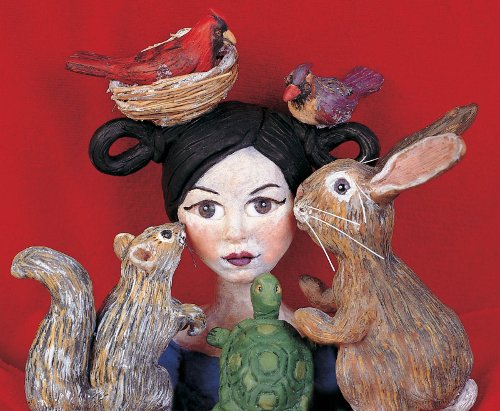
This is author/illustrator Cynthia von Buhler’s self-portrait-slash-doll. I invited Cynthia to 7-Imp this morning to share some art from her latest title, the downright luxurious But Who Will Bell the Cats? (Houghton Mifflin Books for Children; September 2009). This title has been met with such lavish reviews as: “Dark, complicated mixed-media illustrations bring a humorously creepy feel to the tale…this story of an indefatigable mouse should find a welcome place on the shelves of any castle…or library” (Horn Book); “Children will find a lot to discover in the details, even after repeated readings” (School Library Journal); “Beautiful and haunting with the kinds of images kids will pore over, there ain’t nothing like it out there today. A new fable in an all-new style” (Betsy Bird at A Fuse #8 Production); “Young readers will pore over this one again and again” (Kirkus)…Oh, I could go on.
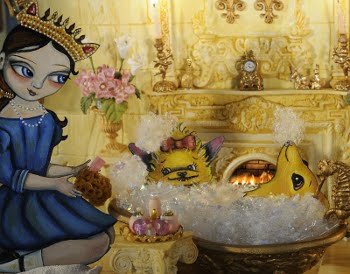 You all know the old Aesop fable, The Mice in Council, about the discussion of belling the cat by those poor mice. Cynthia has embellished this tale with inimitable style, rendered in detailed multimedia collage, adding a stately castle, a princess, an impoverished mouse and his sidekick friend, the Bat, and much more to the tale.
You all know the old Aesop fable, The Mice in Council, about the discussion of belling the cat by those poor mice. Cynthia has embellished this tale with inimitable style, rendered in detailed multimedia collage, adding a stately castle, a princess, an impoverished mouse and his sidekick friend, the Bat, and much more to the tale.
Including gilt. Lots of it. “{W}ouldn’t it be nice to give a princess-obsessed child something gorgeous to the eye with a truly original concept, story, and look, but without the standard pretty pretty princess conceit?” wrote Betsy Bird. Enter Cynthia. This is one stylin’ book, and it’s like nothing I’ve seen this year.
I’ve gotten to where I don’t even like to post about picture books anymore unless I can in some way show some art from it. The added extra benefit of that is I can shut my trap and let the art speak for itself. Or, in this morning’s case, let the artist, as well, tell you in her own words all about the book — and her creative process in bringing it to us. So, without further ado, here’s Cynthia, and I thank her for visiting.
Note: For almost all of these images, which are details of spreads from the book, if you click on the image itself, you will launch another page, which will show you the entire spread from which the detail comes.
“In addition to having written this story, I was also the painter, sculptor, interior decorator, mason, gardener, and plumber of the sets. The rooms were built by hand from wood. The walls were formed from plaster. The floors are hand-made from inlaid wood, mother-of-pearl, and plaster. The characters were painted in oils on gessoed paper, then cut out and placed in the sets. I photographed the scenes with a Nikon D300.
The book was released on September 7, 2009, and the official website features animations, crafts, lesson plans, magic tricks, games, and more. While I was working on the book, I created an in-depth blog for my editor and designer, so they could view my progress. You can view it here.
My book was inspired by Aesop’s age-old question: But who will bell the cats? The book begins with the Aesop fable and veers off considerably from there. I don’t want to spoil the ending, but Aesop’s age-old question finally does get answered!
The Cover
Here’s the final version of the cover image. In it, the mouse is reading a scrap from the original Aesop story upon which my book is based. You can find the full Aesop story inside my book. This is a book within a book. The mouse’s candle is real.
Mouse scratched a few Aesop quotations on his basement wall that were pertinent to his plight:
No act of kindness, no matter how small, is ever wasted.
Slow but steady wins the race.
Persuasion is often more effectual than force.
This is a visual surprise printed on the hardcover book under the dust jacket. The cat with the beret, Claire, is in the exact same place as she is on the dust jacket cover. This is to emphasize the inside/outside and upstairs/downstairs aspect of the book. These cats were painted individually and cut out, but I made them much larger than the cut-out characters inside the book.
The Aesop Room
This is a detail from the opening prologue scene. It is set long ago in ancient Greece, so the mice are wearing togas and sandals. I plastered the whole wooden frame, then painted the cat fresco on the back wall using gouache. After I finished painting the fresco, I sanded certain areas and dripped water onto the whole thing so it would look aged. The floor is also plaster that has been carved into stone shapes and painted.
The characters were painted with oils on gessoed paper before they are cut out. I shot light through an arched door opening on the right so it would look like natural lighting.
The Characters
Here are the final hanging portraits of some of the cats and the princess. I painted one of these per day for nine days. They are very tiny oil paintings (five inches tall by three inches high), small enough to hang on the castle walls. The frames are made of plaster. The wallpaper was painted with old, thick house paint and then wiped away in areas to make it look aged. This is the same paint I used for the Victorian house in my last book, The Cat Who Wouldn’t Come Inside. Did you notice that the crown on the princess has cat ears? You can download posters of all the characters from my book at decorateyourdungeon.blogspot.com.
The Castle Exterior
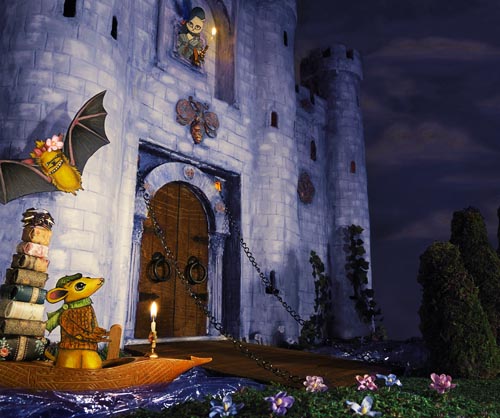
Below is the image that was the runner-up for the cover. (It came in second place in my online cover poll.) We used this page inside the book instead of on the cover. The water is Saran Wrap laid on top of dark blue paper. I made the grass and trees out of real moss. The mouse oar is a popsicle stick from a Fudgesicle that I ate — yum! The sky was hand-painted with gouache on canvas. Once again, both of the candles and flames are real.

The door knockers are drawer pulls. Thanks to my father, the drawbridge really works! I adore castles. I own a castle-esque house on Staten Island in New York City. It inspired me, but there are no mice that live there. All of the mice live with me at my other house in Connecticut. My cats captured many mice when I first moved into the CT house. Like the Princess in my book, I rescued them, gave them a hunk of cheese, and returned them to safety. Now I use humane plug-in sound devices. The mice don’t like the sound and they move elsewhere.
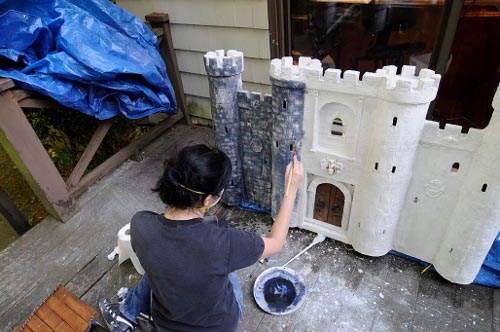
The Castle Courtyard
This is the final version of the title and dedication page. I made the stone floor with plaster of Paris. I troweled it on, and as it dried I carved the stone shapes. Afterwards, I painted it with gouache. I enclosed the stone floor with real, little pebbles. The water in the fountain is Saran Wrap. It looks real, doesn’t it? The flowers are silk, but the grass and trees are real moss from my garden. The candles in the chandeliers are real. The peacocks are made from real peacock feathers. Inside, you can see the ballroom floor. The gold-leaf chairs were given to me by my neighbors, Charlotte and Ulrik Poulsen. Ulrich brought the chairs from China and generously gave them to me for my sets. They were dark wood, and I painted them gold.
The Dungeon
I mixed up dry plaster of Paris and then, using a trowel, I smoothed it onto the wall, like frosting. As it dried, I scratched lines into it with an X-Acto Blade. When it dried, I painted it with gouache, dabbing up some paint with a paper towel to give it a mottled look. I shot light down through the floorboards to get the wonderful “natural” lighting. My father and I built it with slats in the ceiling so I could use light to get that light-creeping-through-the-cracks effect. Mouse is reading scraps from the Aesop fable. This scene takes place in Fall, so I added colored leaves on the floor and steps.
The pipes are from a hardware store. I painted them with a special “rusting” paint. I wanted this scene to look cold so it would provide contrast to the warm, cozy feeling of castle’s powder room. I added some snow and a couple of icicles. The water is Saran Wrap. The snow is glitter. The icicles are a clear glue. This scene takes place in the winter. Brrrrrr!
Mouse is waiting for crumbs to fall through the floor cracks. Poor Mouse! The items on his wall are real French stamps, pictures, and fruit-crate labels. The donkey on the circular paper (not shown here) is a French optical toy. If you pull the strings taut, the paper spins and you see the optical illusion of a person sitting on the donkey’s back. His table is a spool of thread.
Mouse and Brown Bat go upstairs to give a fashion show. The bells are real.
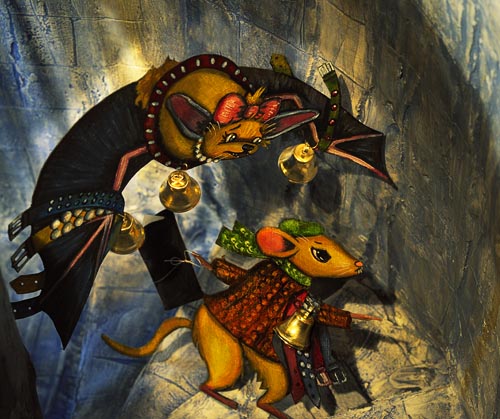
The Powder Room
I was influenced by the bathroom of Colleen Moore’s Dollhouse Castle at the Museum of Science and Industry. In her dollhouse, probably the most beautiful and creative dollhouse in the world, she had artisans use mother of pearl for the floors. I loved the shiny, seashell look, but mother of pearl tiles are amazingly hard to find. I finally tracked them down and ordered them from China. I glued each tile to the wood floor. Moore’s dollhouse was a big influence throughout my book. I didn’t have teams of artisans or an unlimited bank account to make my castle, but I think that my rooms wouldn’t look out of place in her castle. I found the dried seahorse at the beach. I cut it in half, painted it with gold leaf, and attached it to the tub as a faucet. The tub was an old soap dish. The water is Saran Wrap, and the bubbles are cotton batting with glitter. Veronique is having a bit of bubbly after a long day of lolling around.
Claire is on the loo. I bought a wooden toilet and plastered it to look like stone. Claire is reading Le Monde.
The Library
The library is my favorite scene from the book. Everyone is reading French books, magazines, and newspapers (except for Catherine who is looking at a picture book about Colonial Williamsburg). Claire is playing Cat’s Cradle, while Jacqueline, sitting next to her, reads how to do it. It is Fall during this scene, so the flowers are autumn arrangements. The princess sits on the floor so her spoiled cats can have the chairs. This scene was inspired by the library at my Connecticut house. My cats are always sitting on the chairs and couches. I end up sitting on the floor, but I don’t mind.
On the walls, you’ll see details from some of my fine art paintings. I stained the wood panel squares and glued them to the wall. The statuary on the bookshelves are from my husband’s trips to Asia when he was a little boy. The plaster fireplace, doorway pediment, and columns were all painted with gouache. The rug was hard to find. They don’t make such large dollhouse rugs. I found it in Canada. The candles are all real. In fact, they lit up the scenes so much I didn’t need to use too much strobe light. Through the door, you can see the billiard room with an ornate pool table.
Mouse has escaped once again, thanks to Bat. I wanted a few of the scenes to have unusual compositions. Here, we are looking down on the scene from above. I made the paddles out of balsa wood and colored foam. I painted the white lines on the foam with enamel paint.
The Ballroom
The French lion and unicorn tapestries were cut from one large tapestry. I painted the dollhouse piano and harp with gold leaf.
It is Spring, so there are pink and white flower arrangements. The feathers on the cats’ masks are real. As always, the candles are real with lit flames. The cats’ party guests are a deer and an owl.
Here is a detail of the final hockey photo with snow added.

The Dining Room
My sister, Veronica, made the fish out of clay. The punch bowl is actually a little salt serving bowl I found in an antique store. I thought it looked like a punch bowl, so I bought it for the book. The punch is water colored with paint. The painting on the wall is one of my own creations. I wanted the cats to look animated, as though they were having conversations and sharing food. Claire is wearing an Alice-in-Wonderland dress.
The Bedroom
I bought some antique French embroidered lace and gave it to my mother so she could sew it into coverlets. My mother also cut up an old silky blouse from the 1970s for the bed curtains and linens. This is a lilac-toned version. My editor and I really liked the lilac-colored room, but in the end we felt that the golden tones was a better match for the facing page. {Click to see the full spread.} The colors are achieved by placing colored gels in front of my lights. There is a great animation of this on my website where the cats are snoring and their chests move up and down. You have to check it out.
Mouse is sleeping in a matchbox. His blanket is an old, ripped, smelly sock. He has a clothespin on his nose. In the final image, I added a clothespin to the Mouse’s nose; it brings more attention to the smelly sock. I think that the light coming through the floorboards really works well.
The Kitchen
The white flour is actually some of the plaster dust I use to make the walls. The cats are messy chefs.
My Future
I’m really excited about signing on with The Gotham Group to make my ideas into films and TV shows for children. I’m currently illustrating a graphic novel for Dark Horse Comics. It is about conjoined twins, and it is a collaboration with a band called Evelyn Evelyn. Neil Gaiman is writing the foreword. I’m also writing a young adult book, and I plan to make it into a film. I don’t want to give away the idea, but it takes place in The Black Forest of Germany, and it is filled with magic realism.“
Note: The Nassau County Museum of Art in Roslyn Harbor, New York, is running an exhibit about the book, on view until January 3, 2010.
Cynthia’s self-portrait © Cynthia von Buhler 2007.
BUT WHO WILL BELL THE CATS? Text and illustrations copyright © 2009 by Cynthia von Buhler. Published by Houghton Mifflin Books for Children, New York, NY. Reproduced by permission of the illustrator.
All other images used with permission of Cynthia von Buhler.
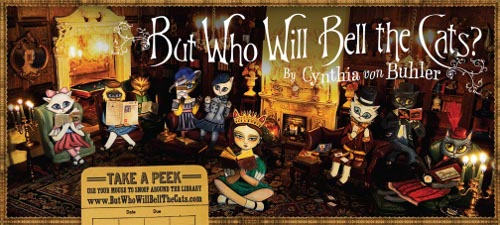
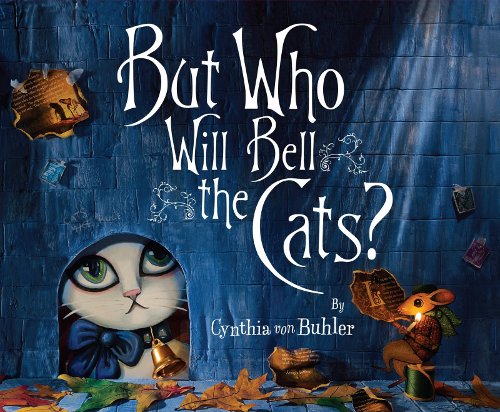
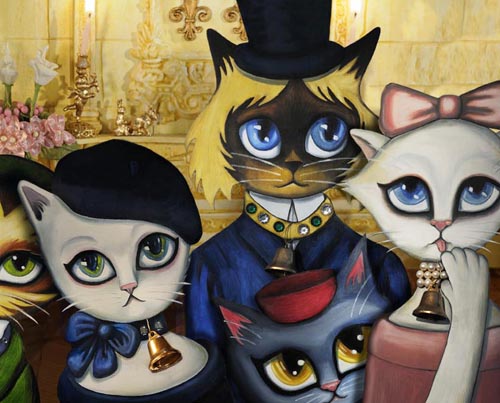
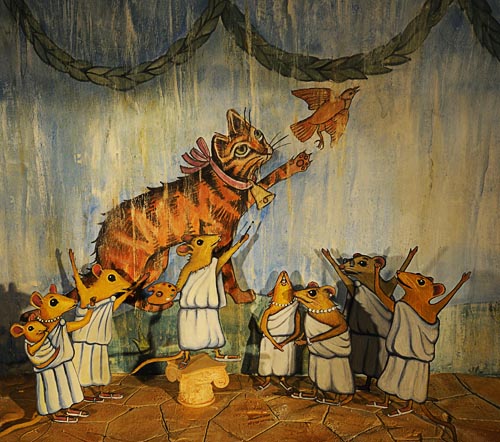
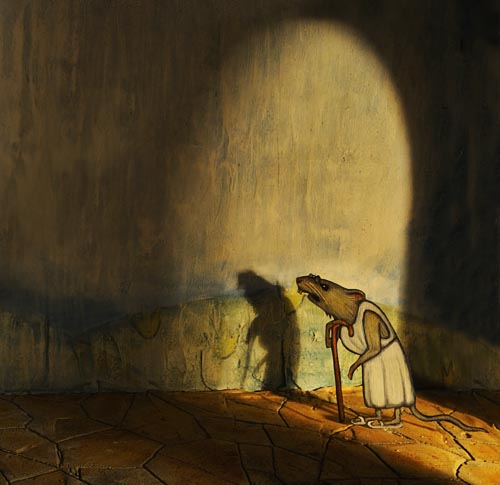
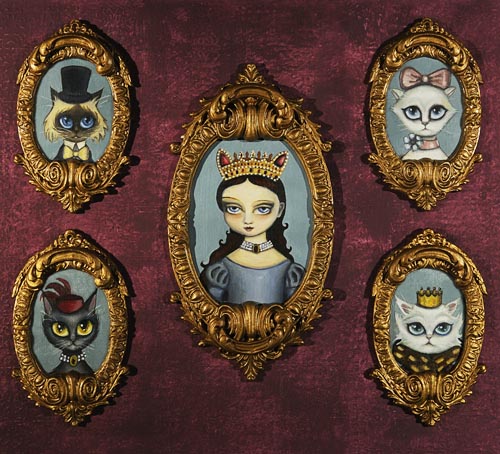

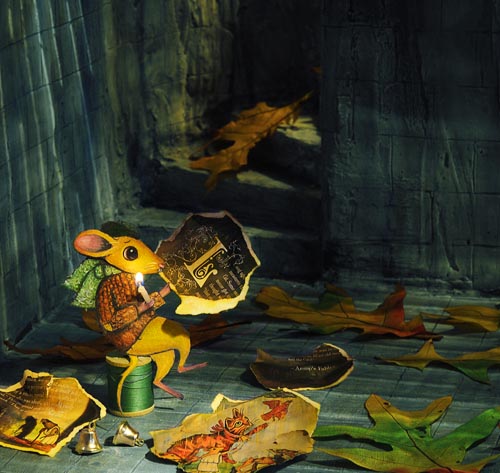
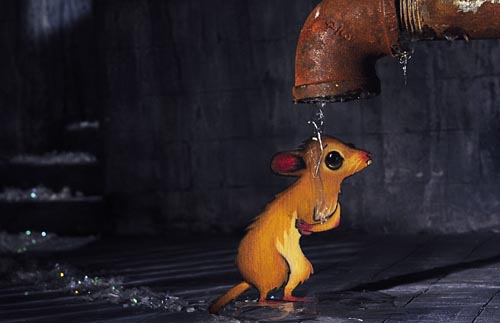

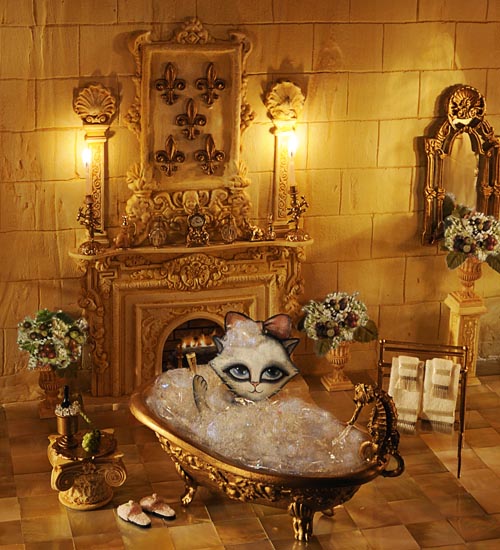


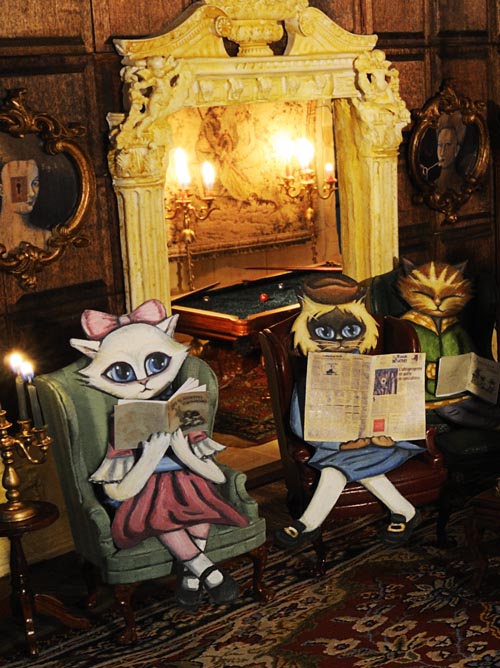

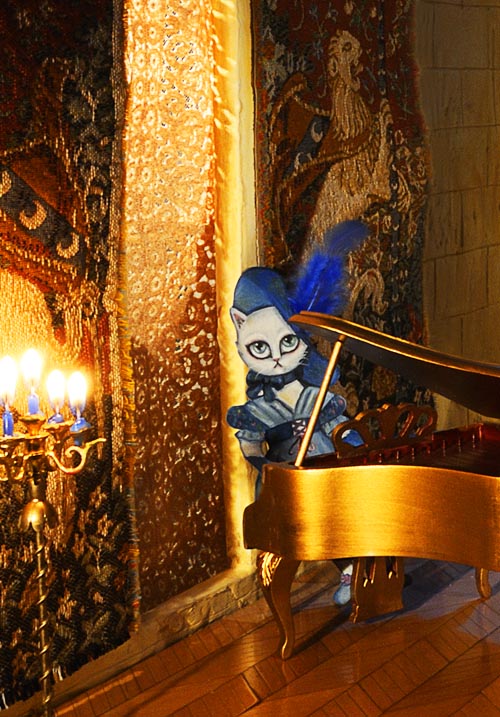


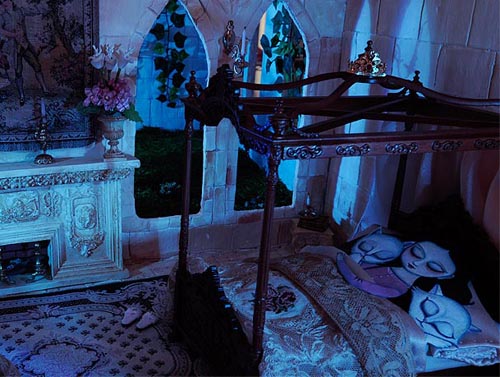
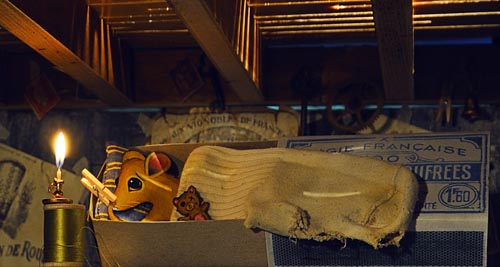
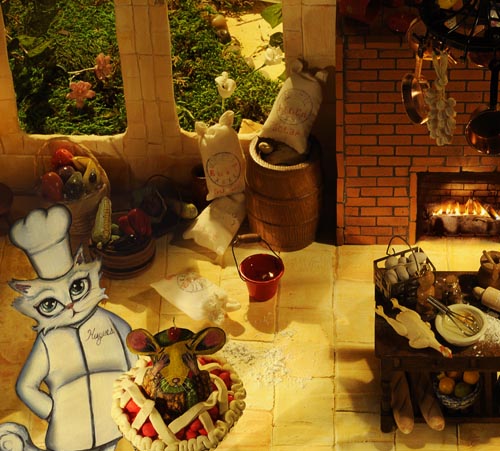

How CUTE! Bonus points for including Siamese, and for giving Princess Gabrielle a tiara with cat ears AND a great outlook (Princess Gabrielle: “It’s nice to be important, but it is more important to be nice.”)
Fabulous! I loved seeing how Cynthia made those, and knowing the little details, like that the candles were really lit.
Sounds like she is a busy person! I look forward to her future projects.
Wow! Cynthia gives the phrase, “attention to detail” new meaning. I’m blown away by these spreads. Of course, my favorite is the kitchen (little eggs, mouse pie!). And the bathtub that was a soap dish. Working drawbridge. Amazing and brilliant!
What a beautifully crafted and amazing miniature universe! Thanks for letting us peek inside of it.
Goodness gracious, this stuff is both droll and exquisite!
I love Cynthia’s work! She is brilliant, beautiful, and sinfully talented.
Pardon my indelicacy, but… Holy CRAP!. For once I’m speechless.
Well (ha!), except to comment on this line: “Here is a detail of the final hockey photo with snow added.” In that sentence are so many little doors opening into whole gobsmacking worlds of meaning: “a detail” (eGAD, there’s MORE?!?), “the final” (this is a SEQUENCE?!?), “hockey” (double-spit-take: HOCKEY?!?), “with snow added” (you mean there’s another scene WITHOUT snow?!?).
I hope Cynthia con Buhler’s real-life castle has many rooms in which to store her work. Despairing, the thought that any of it might go away at the end of a given project.
An amazing writeup about this book. Thanks to her for sharing it (and congratulations to you, Jules, for scoring it).
Love all of the details and the awesome real life castle!
Beautiful and amazing !
Betty Jane Covington
Oh My,,, these paintings speak volumns
I just love them
Hi! These are beautiful! Would it be possible to get one of these images as a print? Maybe the Dining Room, the Ballroom, or the Library? Thanks!